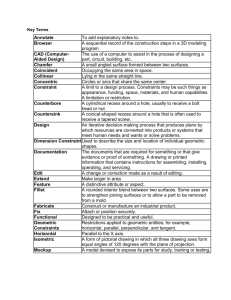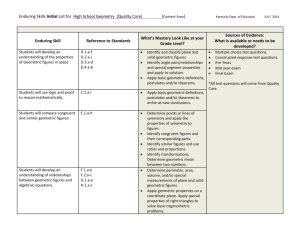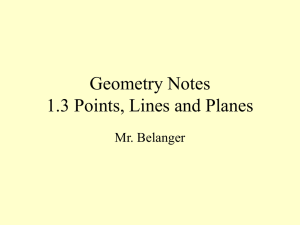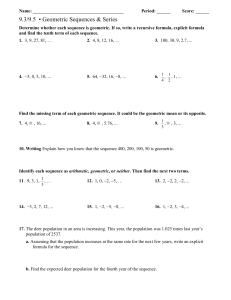UNIT 01 – LESSON 01 Points, Lines and Planes. Definitions
advertisement
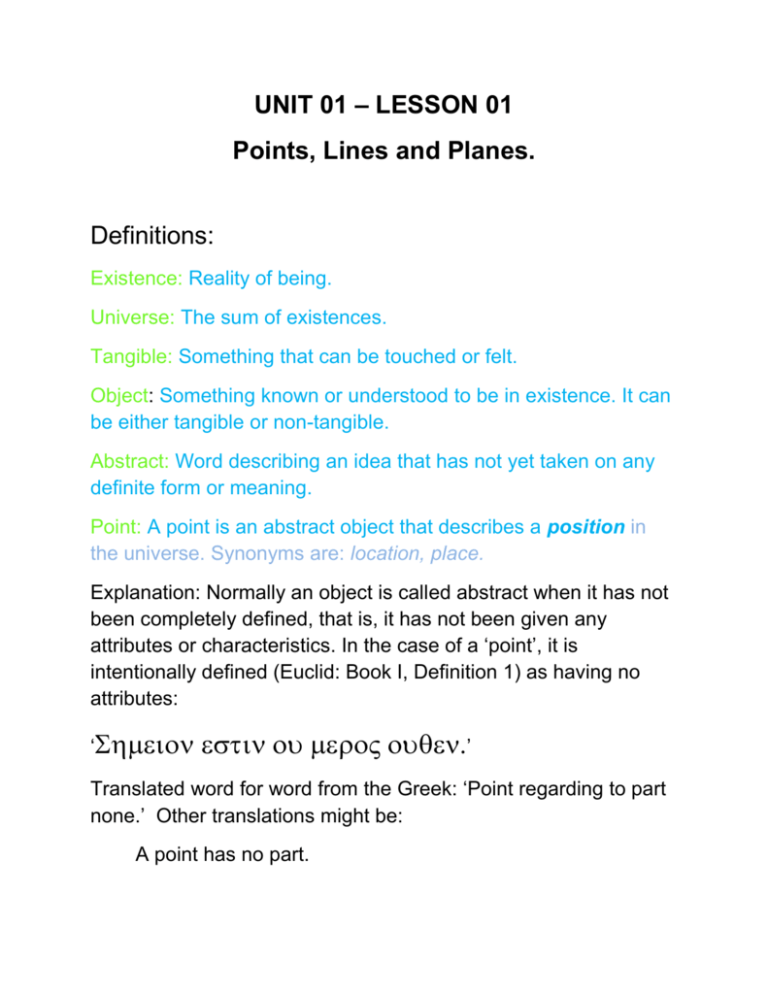
UNIT 01 – LESSON 01 Points, Lines and Planes. Definitions: Existence: Reality of being. Universe: The sum of existences. Tangible: Something that can be touched or felt. Object: Something known or understood to be in existence. It can be either tangible or non-tangible. Abstract: Word describing an idea that has not yet taken on any definite form or meaning. Point: A point is an abstract object that describes a position in the universe. Synonyms are: location, place. Explanation: Normally an object is called abstract when it has not been completely defined, that is, it has not been given any attributes or characteristics. In the case of a ‘point’, it is intentionally defined (Euclid: Book I, Definition 1) as having no attributes: ‘’ Translated word for word from the Greek: ‘Point regarding to part none.’ Other translations might be: A point has no part. A point has no parts. A point has no extent (dimension). The ancient Greek mathematician Euclid, used an abstract definition for point because the concept of point would be used concretely (as opposed to abstractly) in defining all other geometric objects. Geometric objects are inherently non-tangible. For example, it is impossible to create an object called a line, plane, triangle, square or any other geometric object. All these objects already exist and have always existed. These objects represent paths or routes in a coordinate system. One can only depict (represent) a mental image of such objects. This process is called visualization. Euclid was designing a system of abstract measure intended to enable quantification using any measure. In fact, Euclid introduced numbers as line segments, the smallest of which is the unit. For this lesson, we will always think of a point as a location or position. It is impossible to define either location or position without using ‘self-reference’. A self-referential definition is one that uses the word or concept in defining the same. Indeed, the task now facing us is that of defining a location or position mathematically. Location: A location is the distance from another location. The previous definition is self-referential because location is used before it is defined to define the same. Imagine the universe is a straight path extending infinitely in either direction. Using this idea, we can devise a simple mathematical system that allows us to attribute the concept of distance to location. We need a fixed location that we can call an origin. Let this location be associated with zero distance. All other locations can only be defined relative to the origin, that is, the proximity (how far or near) of another location becomes its defining attribute. Exercise 1: Work in groups of two whilst exchanging ideas. Using the straight path example, develop a method that describes how you can start at one location and arrive at another. Your method must describe the process step by step. For example, suppose you have location A and location B, your method must show how to start at A and end at B. Now introduce location C and show how you can arrive at C without any knowledge of A or B. Solution: Number line with origin and fixed increments. Location A and B at a given fixed increments. Exercise 2: Now imagine the universe is the white or black board. Devise a method to travel from one location to another. Solution: Cartesian plane with origin and fixed increments. Definitions: Distance: An idea relating how far one location is from another. Path: A road or route between any two locations. Between any two locations or points that are different, there are many paths. The shortest distance between points is called a line (or straight line) or a geodesic. In the first exercise, the distance between any two points is always a line since the universe is defined as a straight path. In the second exercise, the distance can change because many paths exist between different points. Symptom: A characteristic sign or indication of the existence of something else. Two different points are one symptom of the geometric object we call a line. Line: The shortest distance between any two points. In the above figure, we see a visualization of four different paths between the points A and B. The black dots at A and B are visualizations of points. It is important to note that all of the illustration in figure 1 is only a mental image of intangible geometric objects – in this case points and paths (one path is depicted as straight, one as a collection of straight paths shown and the remaining two paths colored in black and red are not straight). Points located on the same line are called collinear. We can also say points that ‘lie’ on the same line are collinear. Points that do not lie on the same line are non-collinear. Lines intersect in one point, all points or not at all. Lines that intersect in all points are the same line. Plane: A surface containing all straight lines that connect any two points lying in the surface. Geometric objects that lie in the same plane are called coplanar. Geometric objects not in the same plane are called non-coplanar. Lines in the same plane that never intersect each other, no matter how large the plane becomes, are called parallel lines. Skew lines are non-coplanar lines that never intersect each other. A rectilinear object is composed only of straight lines. Exercises: 1. The intersection of a line not all contained in a plane and the plane itself is called a _____. 2. The intersection of two planes that do not coincide in all points is called a ______. 3. For the following symptoms, name the geometric object: a. Two different points that are collinear and have between them an infinite number of collinear points. b. Four different points such that any two of the four points are always equidistant from the remaining two points. c. Three different points not all collinear, such that any one point is collinear with the other two points. d. Infinitely many points or lines all lying in a flat surface in any direction. e. A point positioned exactly the same distance from an infinite number of different points. Summary: A point or location is not well defined (or completely defined). However, a straight line and plane are well defined geometric objects derived from the definition of point. A line that is not straight, is a path or curve that is defined as a distance between two points. The fundamental geometric object is therefore the point and all other geometric objects are derived from it. More complex geometric objects are derived from less complex objects as illustrated in Figure 5. Objects are represented up to three dimensions. It is possible to construct geometric objects in higher dimensions that cannot be visualized. For example, consider lines of longitude that have a time attribute associated with each line. We could construct these lines in three dimensions and add a fourth dimension in the form of time. Figure 6 demonstrates a more complex geometric object that is a curved surface.


